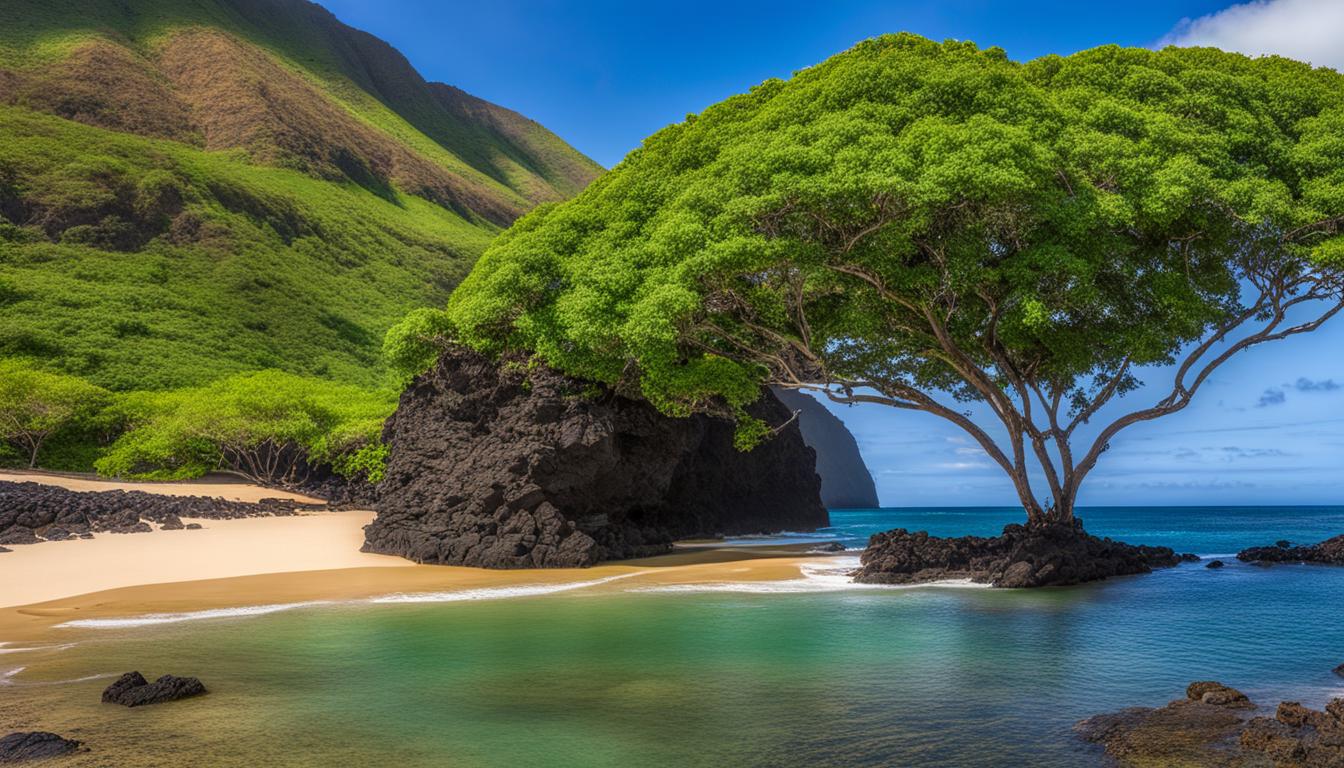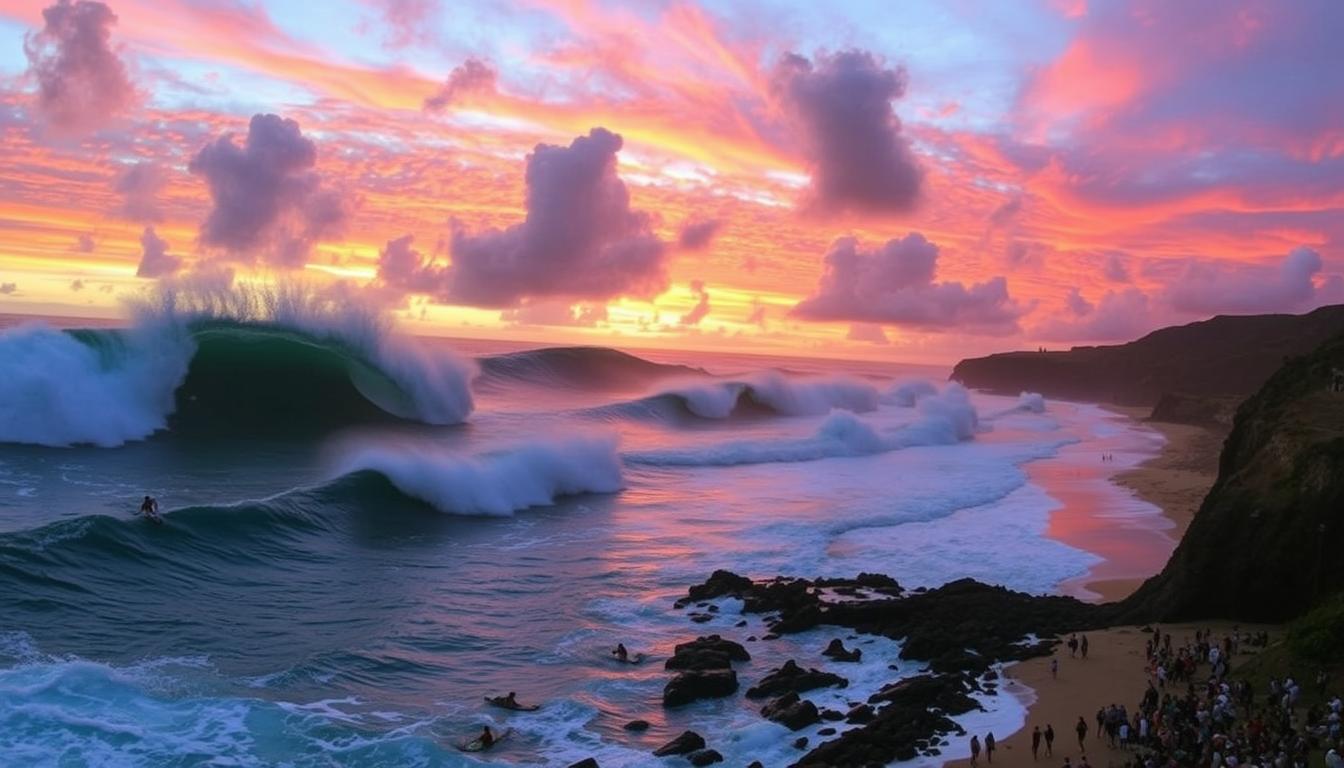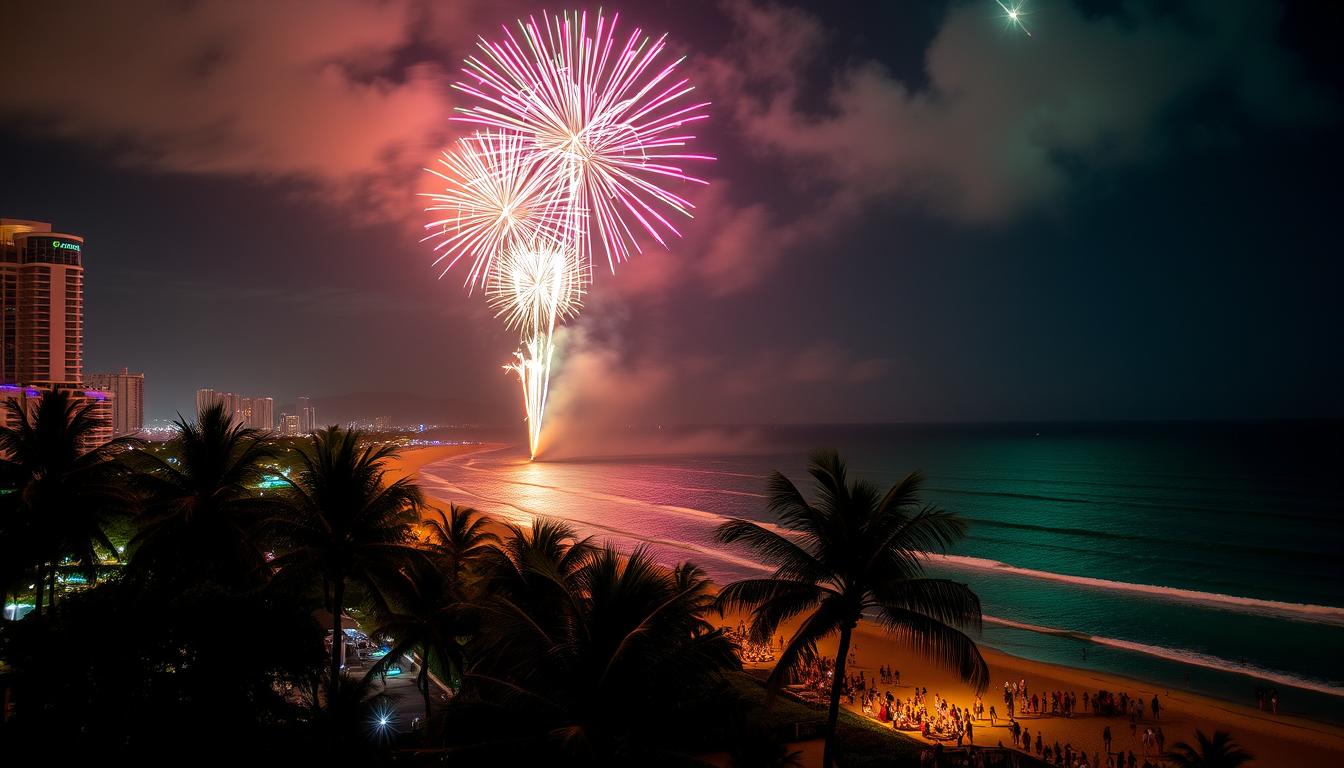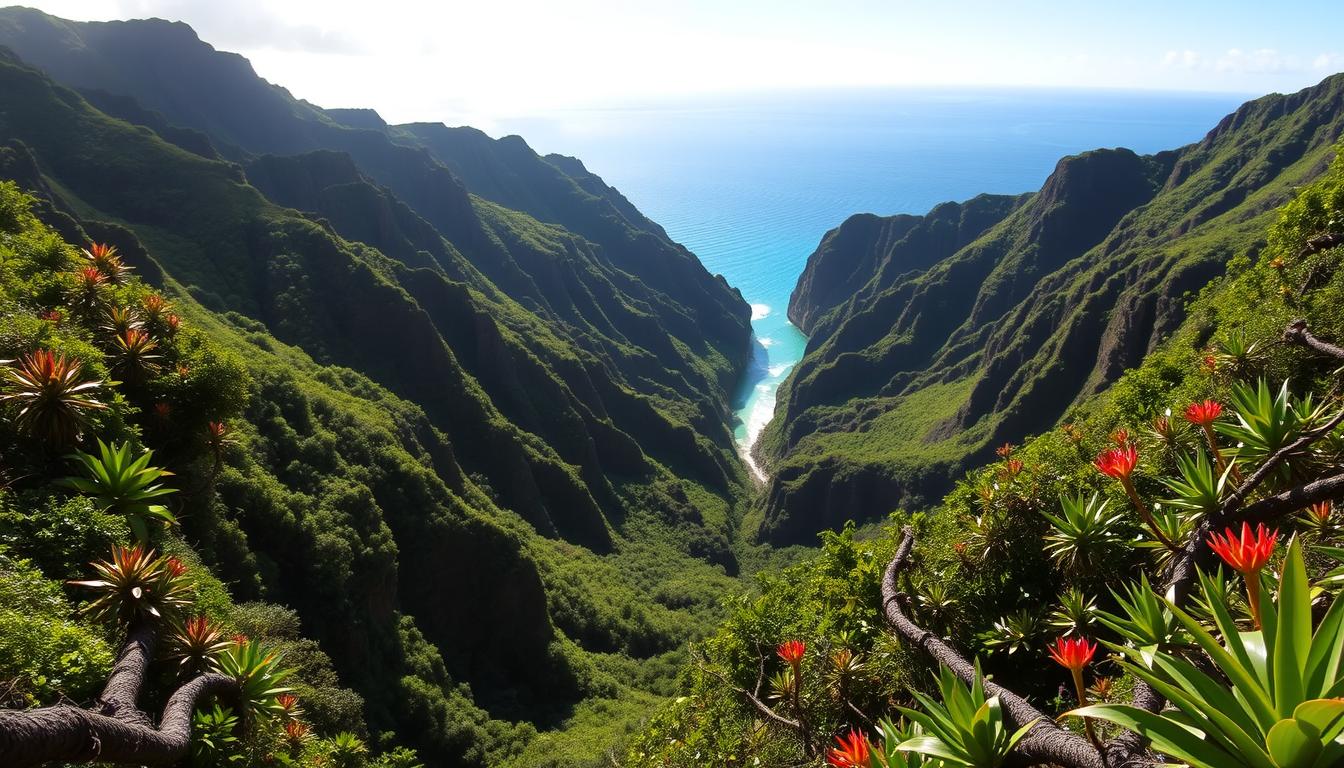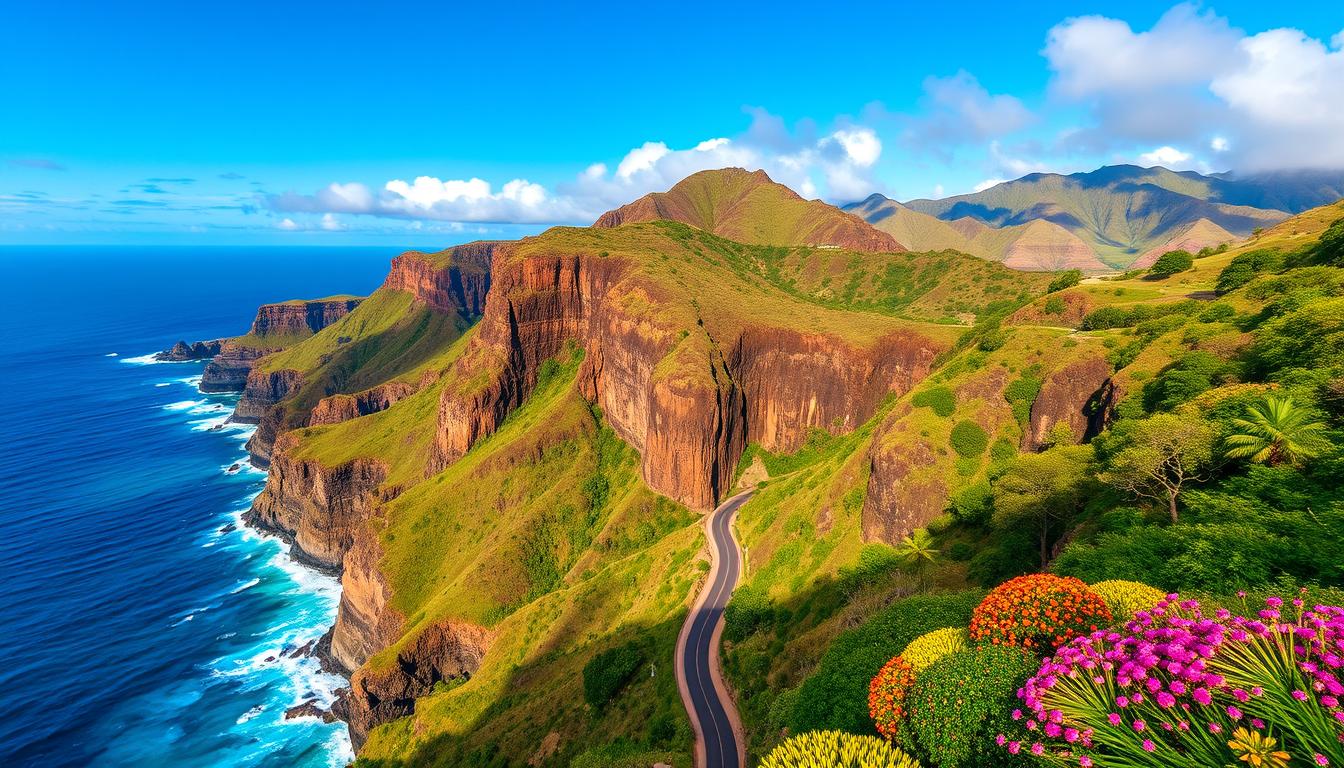Hidden in the serene Halawa Valley on the island of Molokai, Hawaii, lies a true gem for those seeking the beauty of old Hawaii. Halawa Park Molokai offers a picturesque escape surrounded by lush foliage-covered cliffs, stunning landscapes, and a rich cultural heritage. Whether you’re an outdoor enthusiast, a history buff, or simply seeking tranquility, Halawa Park has something special to offer.
Key Takeaways:
- Halawa Park Molokai is a hidden gem nestled in the Halawa Valley on the island of Molokai, Hawaii.
- Surrounded by lush cliffs and breathtaking landscapes, the park offers a serene and picturesque escape.
- Halawa Park Molokai provides opportunities for outdoor activities, cultural immersion, and relaxation at its pristine beaches.
- Explore scenic hiking trails, historical sites, and witness the majestic Moa’ula Falls while visiting Halawa Park.
- Respect the cultural significance of the area and follow safety guidelines while visiting this remote and sacred location.
Discover the Scenic Hiking Trails of Halawa Valley
The Halawa Valley is a hiker’s paradise, offering a variety of scenic trails that showcase the natural beauty of this hidden gem. Whether you’re a seasoned hiker or a beginner, there are hiking options available for all levels of experience. One of the most popular trails is the Halawa Valley Hike, a family-friendly three-mile journey that takes approximately 4-5 hours to complete.
During the Halawa Valley Hike, you’ll have the opportunity to witness the iconic Moa’ula Falls, a towering 250-foot waterfall that will leave you in awe of its majestic beauty. As you traverse the trail, you’ll also come across ancient Hawaiian Heiaus, sacred temples that offer insights into the rich cultural heritage of Hawaii. The trail is also lined with native plant species, providing an educational experience on the local flora and fauna.
For those seeking a more adventurous hike, there are additional trails available in Halawa Valley that will take you deeper into the lush landscapes. These trails offer breathtaking views of the valley’s cliffs, streams, and waterfalls. As you explore the trails, keep an eye out for the diverse wildlife that calls Halawa Valley home, including native bird species and colorful butterflies.
Halawa Valley Hiking Trails Summary:
| Trail Name | Difficulty Level | Trail Length | Estimated Time |
|---|---|---|---|
| Halawa Valley Hike | Easy | 3 miles | Approximately 4-5 hours |
| Advanced Halawa Valley Trail | Moderate | 5 miles | Approximately 6-7 hours |
| Halawa Valley Waterfall Trail | Difficult | 7 miles | Approximately 8-9 hours |
Whether you’re seeking a leisurely hike or an adrenaline-pumping adventure, the hiking trails of Halawa Valley offer something for everyone. So put on your hiking boots, grab your water bottle, and get ready to embark on an unforgettable journey through the breathtaking landscapes of this hidden gem.
Immerse Yourself in the Cultural Heritage of Halawa Valley
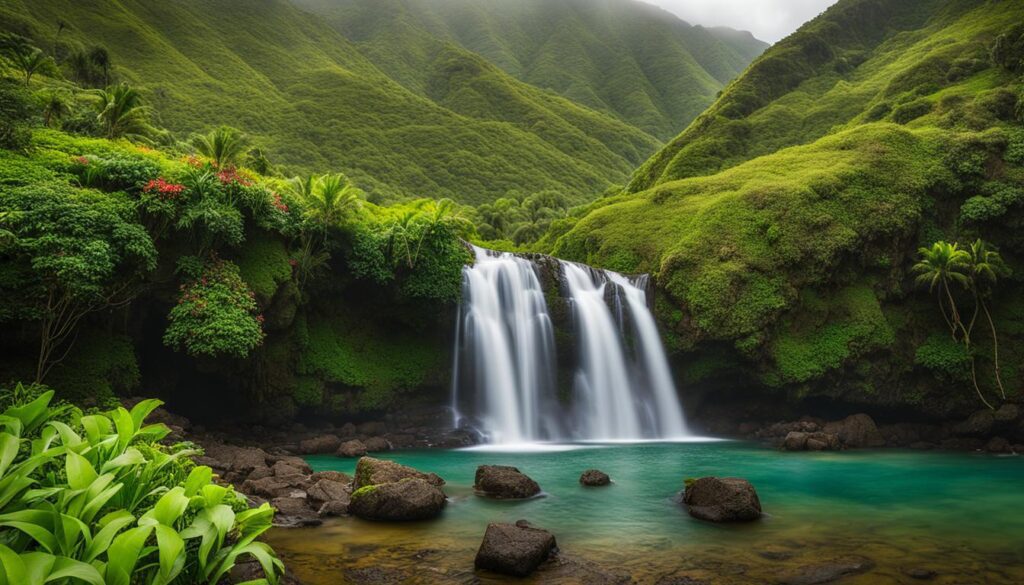
Halawa Valley offers visitors a unique opportunity to not only explore its natural beauty but also to immerse themselves in the rich cultural heritage of Hawaii. A cultural hike through the valley provides a glimpse into the history and traditions of the original Hawaiian people who once inhabited the area. The valley is known for its sacred temples and preservation efforts, making it a truly educational and enlightening experience for tourists.
During the cultural hike, visitors can learn about the rituals and customs that shaped the lives of the valley residents. Knowledgeable guides share stories and insights about the ancient Hawaiian practices, providing a deeper understanding of the valley’s significance and its connection to the island’s history. Exploring the sacred temples offers a sense of reverence and respect for the cultural heritage that still resonates in the valley today.
Preserving the Cultural Heritage
The preservation efforts in Halawa Valley are essential for maintaining its cultural heritage. Local communities and organizations work diligently to protect the valley’s historical sites and ensure that future generations can continue to learn from and appreciate its unique cultural significance. By visiting Halawa Valley and supporting these preservation efforts, tourists contribute to the sustainability of the valley’s cultural heritage and help protect it for years to come.
| Highlights of Cultural Hike in Halawa Valley | Temples | Rituals | Traditional Practices |
|---|---|---|---|
| Learn about the history and traditions of the original Hawaiian people | Explore the ancient sacred temples scattered throughout the valley | Witness traditional rituals and ceremonies | Engage in hands-on experiences, such as lei making or hula dancing |
| Discover the spiritual significance of the valley’s landmarks | Experience the serenity and peace inside the temples | Gain insights into the daily lives of the valley’s indigenous people | Connect with the land and its cultural roots |
| Develop a deeper appreciation for Hawaii’s cultural heritage | Learn about the preservation efforts to protect the valley’s cultural sites | Understand the importance of sustainability and respectful tourism | Immerse yourself in the authentic traditions and practices of Hawaii |
Relax at the Serene Beaches of Halawa Valley
After a day of hiking and exploring the cultural heritage of Halawa Valley, visitors can unwind at its picturesque beaches. The valley is home to several serene swimming coves and sandy stretches, offering a tranquil retreat amidst the stunning natural beauty.
Pāpōhaku Beach Park, also known as “Three Mile Beach,” is one of the highlights of Halawa Valley. With its golden sands and crystal-clear waters, it provides the perfect setting for sunbathing, beachcombing, and picnicking. The beach is relatively secluded, ensuring a peaceful and intimate experience.
Another idyllic beach in the area is Slaughterhouse Beach. Known for its dramatic cliffs and rocky outcrops, it offers breathtaking views and a unique ambiance. The beach is popular among snorkelers and scuba divers due to its vibrant underwater ecosystem, making it an ideal spot for underwater exploration.
Beach Comparison Table
| Beach | Description | Activities |
|---|---|---|
| Pāpōhaku Beach Park | A long stretch of golden sand with crystal-clear waters | Sunbathing, beachcombing, picnicking |
| Slaughterhouse Beach | Surrounded by dramatic cliffs and rocky outcrops | Snorkeling, scuba diving, beachcombing |
Whether you’re seeking relaxation or adventure, the beaches of Halawa Valley offer something for everyone. Spend a lazy afternoon basking in the sun, stroll along the shorelines, or delve into the underwater wonders. These serene havens provide the perfect opportunity to rejuvenate and connect with nature in the idyllic setting of Halawa Valley.
Explore the History and Ruins of Halawa Valley
Halawa Valley is not only known for its natural beauty but also for its historical significance. The area is dotted with ruins of old historic buildings that offer glimpses into the past. Exploring these ruins provides a unique opportunity to learn about the history of the valley and the people who once inhabited it.
One of the notable historical sites in Halawa Valley is the Mo’oula Church, which was built in the late 19th century and played a significant role in the community’s religious life. The ruins of this church stand as a testament to the faith and resilience of the early settlers.
Another intriguing site is the abandoned sugar mill in Halawa Valley. This mill was once a bustling center of activity during the island’s sugar plantation era. Today, the ruins of the mill offer a glimpse into the island’s past economic reliance on sugar production.
The Historical Sites of Halawa Valley:
| Historical Sites | Description |
|---|---|
| Mo’oula Church | A late 19th-century church that served as a center of religious life in the community. |
| Abandoned Sugar Mill | A remnant of the island’s sugar plantation era, showcasing the history of the island’s economic past. |
Exploring these historical sites allows visitors to connect with the rich heritage of Halawa Valley and gain a deeper appreciation for its cultural significance. It’s a chance to step back in time and imagine the lives of the people who once called this valley home.
Witness the Majestic Moa’ula Falls of Halawa Valley
One of the highlights of Halawa Valley is the iconic 250-foot Moa’ula Falls. This breathtaking waterfall stands as a testament to the natural beauty and power of Halawa Valley. As visitors embark on the journey to reach the top of the falls, they are rewarded with awe-inspiring views of cascading water surrounded by lush greenery.
Reaching Moa’ula Falls requires a hike along the Halawa Valley Trail, offering adventurers a sense of excitement and exploration. Along the way, hikers will encounter various breathtaking landscapes and rich biodiversity, making the journey even more captivating. As they approach the falls, the sound of rushing water grows louder, building anticipation for the magnificent sight that awaits.
Once at the top, visitors can enjoy panoramic views of Halawa Valley and the surrounding lush cliffs. The power and beauty of Moa’ula Falls are truly awe-inspiring, leaving a lasting impression on all who witness it. Whether taking in the view from the top or feeling the mist on their faces as they stand near the base, visitors are sure to be captivated by the majesty of this natural wonder.
With its pristine beauty and serene surroundings, Moa’ula Falls is a must-see attraction in Halawa Valley. Visitors to this hidden gem can immerse themselves in the wonders of nature and experience the power and tranquility of this magnificent waterfall.
Tips for Visiting Halawa Valley
When planning a visit to Halawa Valley, there are a few essential tips to keep in mind to ensure a smooth and enjoyable experience. As this hidden gem is located on the northeastern section of Molokai island, approximately 20 miles from Kaunakakai, it’s important to plan ahead and come prepared.
It is recommended to have a vehicle to reach the valley as it is at the end of Hawaii state highway 450. This allows for easier access and flexibility during your visit. Additionally, keep in mind that most of the land in Halawa Valley is privately owned, so it’s crucial to respect any rules and restrictions set by the owners or parks.
When exploring the valley, be sure to bring appropriate outdoor gear, including comfortable walking shoes, a hat, sunglasses, and sunscreen. As Halawa Valley offers a range of outdoor activities, such as hiking and swimming, it’s also advisable to pack water, snacks, and a swimsuit for taking a dip in the refreshing waters of Halawa Bay.
Accommodation Options Near Halawa Valley
For travelers looking to explore the natural beauty of Halawa Valley in Molokai, Hawaii, there are several accommodation options available in the vicinity. Whether you prefer luxurious resorts or more budget-friendly lodging, you can find a place that suits your preferences and provides easy access to the attractions of Halawa Valley. Here are some recommended accommodation options:
The Ritz-Carlton Maui Kapalua
The Ritz-Carlton Maui Kapalua is an upscale resort located on Napili Bay, just a short drive away from Halawa Valley. With luxurious amenities, stunning ocean views, and world-class service, this resort offers a comfortable and relaxing stay for visitors. Guests can enjoy a variety of on-site dining options, spa services, and access to a beautiful beach.
Montage Kapalua Bay
Another luxurious option near Halawa Valley is Montage Kapalua Bay. Situated on the picturesque Kapalua Bay, this resort boasts spacious suites with ocean views, a championship golf course, and multiple swimming pools. The resort also offers a variety of dining options, a spa, and easy access to nearby attractions.
The Mauian Hotel on Napili Beach
For those seeking a more budget-friendly option, The Mauian Hotel on Napili Beach is a great choice. Located right on the beach, this charming hotel offers comfortable rooms with ocean views and a laid-back atmosphere. Guests can relax on the beach, take a dip in the pool, or explore the nearby shops and restaurants.
Whichever accommodation option you choose, staying near Halawa Valley provides convenient access to its natural wonders and cultural experiences. Whether you’re seeking luxury or a more affordable stay, these options ensure a comfortable and memorable visit to this beautiful nature reserve in Hawaii.
Getting to Halawa Valley
Halawa Valley is located at the far eastern end of the Kamehameha Highway on Molokai island. It is approximately 1.5 hours from Molokai Airport. The valley is tucked away from busier areas and surrounding towns, providing a peaceful and secluded experience for visitors. The drive to Halawa Valley offers scenic views and is a journey in itself.
If you’re arriving by plane, Molokai Airport is the closest airport to Halawa Valley. From there, you can rent a car to make the journey to the valley. It’s important to note that there are limited services and amenities along the way, so be sure to stock up on supplies before embarking on your trip.
As you drive towards Halawa Valley, you’ll have the opportunity to admire the natural beauty of the island. The road winds through lush greenery and offers panoramic views of the coastline. It’s recommended to take your time and enjoy the journey, stopping at viewpoints and lookout spots along the way.
| Travel Information: | Details: |
|---|---|
| Location: | Eastern end of Molokai |
| Nearest Airport: | Molokai Airport |
| Distance from Airport: | Approximately 1.5 hours |
Once you reach Halawa Valley, you’ll find parking available near the entrance. From there, you can explore the valley on foot or join a guided tour to learn more about the area’s history and culture. It’s important to respect the valley’s sacred nature and follow any guidelines or rules set by the park or local community.
A trip to Halawa Valley promises a unique and unforgettable experience. From the moment you arrive at Molokai Airport to the scenic drive towards the valley, every step of the journey is filled with natural beauty and cultural richness.
Safety and Guidelines for Halawa Park
When visiting Halawa Valley, it’s important to prioritize safety and follow guidelines to ensure a enjoyable and respectful experience. The valley is a nature reserve in Hawaii and holds significant cultural and historical value. Here are some safety tips and guidelines to keep in mind:
Stay on Designated Trails
To protect the delicate ecosystems of Halawa Valley, it is essential to stick to designated hiking trails. These trails are carefully planned to minimize environmental impact and ensure visitor safety. Straying off the trails can disturb the vegetation and wildlife, as well as put you at risk of encountering hazards such as loose rocks or steep cliffs. Always follow trail markers and respect any closures or restrictions in place.
Be Mindful of River Crossings
Halawa Valley is home to several rivers and streams that cross the hiking trails. During periods of heavy rainfall, these waterways can become powerful and dangerous. Exercise caution when crossing rivers and check local weather conditions before your hike. If water levels are too high or the current is strong, it’s best to avoid crossing altogether and wait for safer conditions.
Respect the Sacredness of the Valley
Halawa Valley is considered sacred by the Hawaiian people, and it is important to show respect and reverence while visiting. Avoid touching or removing any items of cultural or historical significance, such as stones, artifacts, or offerings that you may come across. Additionally, refrain from loud or disruptive behavior that can disturb the spiritual atmosphere of the valley. By treating the valley with respect, you contribute to its preservation and ensure a meaningful experience for future visitors.
By following these safety tips and guidelines, you can make the most of your visit to Halawa Valley while protecting its natural beauty and cultural heritage.
The Unique Adventure of Halawa Valley
A visit to Halawa Valley offers a unique adventure, allowing visitors to escape the tourist traps and witness the natural, authentic beauty of Hawaii. Located in the serene Halawa Valley on the island of Molokai, this hidden gem is a must-visit destination for those seeking a genuine and immersive experience.
Dotted with lush foliage-covered cliffs and surrounded by stunning landscapes, Halawa Park Molokai offers a remote and untouched environment. This secluded location provides an opportunity to disconnect from the hustle and bustle of everyday life and immerse yourself in the tranquility of nature.
Exploring Halawa Valley is like stepping back in time. The valley is rich in cultural heritage, with sacred temples and ancient Hawaiian ruins scattered throughout the area. Visitors can take a cultural hike through the valley, learning about its history and the original Hawaiian people who lived there, providing a unique and educational experience.
Whether you’re hiking the scenic trails, relaxing at the serene beaches, or witnessing the majestic Moa’ula Falls, a visit to Halawa Valley will leave you with unforgettable memories and a deeper appreciation for the natural wonders of Molokai. Embark on this one-of-a-kind adventure and discover the true beauty of Hawaii in Halawa Valley.
FAQ
Is there an entrance fee for Halawa Park Molokai?
No, there is no entrance fee for Halawa Park Molokai. However, it’s important to respect any rules and restrictions set by the owners or parks.
What are the hiking trails like in Halawa Valley?
The hiking trails in Halawa Valley are scenic and suitable for hikers of all levels. The Halawa Valley Hike is approximately three miles long and takes around 4-5 hours to complete.
Can I swim at the beaches in Halawa Valley?
Yes, there are several swimming coves and beaches in Halawa Valley where visitors can relax and enjoy the waters. Popular beaches include Pāpōhaku Beach Park and Slaughterhouse Beach.
Are there accommodations near Halawa Valley?
Yes, there are several accommodation options available on the main section of Molokai island. Some hotels near Halawa Valley include The Ritz-Carlton Maui Kapalua, Montage Kapalua Bay, and The Mauian Hotel on Napili Beach.
How do I get to Halawa Valley?
Halawa Valley is located on the northeastern section of Molokai island. It is approximately 20 miles from Kaunakakai and can be reached by driving on Hawaii state highway 450.
What should I bring when visiting Halawa Valley?
It’s advisable to bring water, snacks, and a swimsuit for the falls. Additionally, be aware of the limited phone signal at this remote location and plan accordingly.
What is the significance of Moa’ula Falls in Halawa Valley?
Moa’ula Falls is an iconic 250-foot waterfall in Halawa Valley. Hikers can embark on a journey to witness the breathtaking views from above and appreciate the beauty and power of nature.
Is Halawa Valley safe to visit?
While Halawa Valley is generally safe, visitors should prioritize safety and follow guidelines. Be cautious while hiking, particularly during river crossings and in muddy or overgrown areas.
Can I explore the historical ruins in Halawa Valley?
Yes, Halawa Valley is dotted with ruins of old historic buildings that offer glimpses into the past. Exploring these ruins provides a unique opportunity to learn about the history of the valley.
What is the cultural heritage of Halawa Valley?
Halawa Valley offers a chance to immerse yourself in the rich cultural heritage of Hawaii. Visitors can take a cultural hike through the valley, learning about its history and the original Hawaiian people who lived there.
Is Halawa Valley crowded with tourists?
Halawa Valley is tucked away from busier areas and surrounding towns, providing a peaceful and secluded experience for visitors. It is not as crowded with tourists compared to other popular destinations in Hawaii.

Scott Sweeney is the creator of Virtual Hawaii 360. Scott is a professional marketer and a lifelong Hawaii enthusiast. Scott splits time between Oahu and Dayton, Ohio. In addition to his marketing endevours, he is also a published Ukulele musician.

